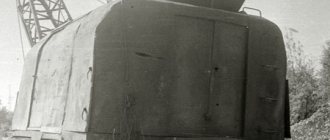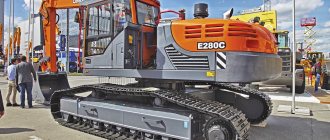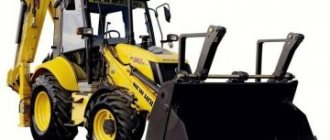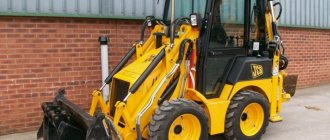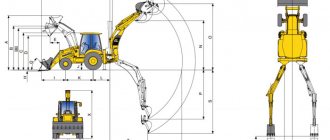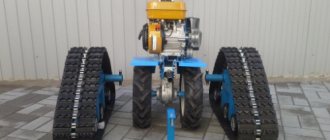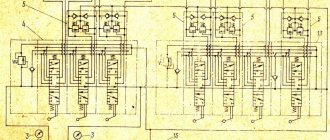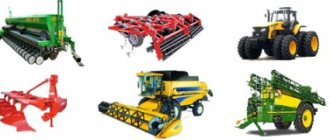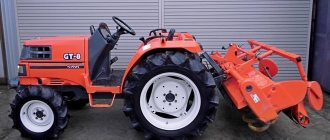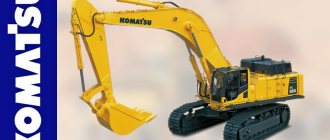An excavator, in many cases, may be the only equipment capable of performing a certain scope of work. In 95% of cases, excavation work is performed using a bucket. A typical representative of this class of earth-moving machines is a single-bucket excavator, which will be discussed.
Types of excavator working equipment
The functionality of this specialized equipment depends on the use of the work equipment. Digging soil is the main task of an excavator. Its solution is provided by equipment called basic.
This includes:
- mechanical shovel (direct and reverse);
- grab;
- bucket rotator;
- dragline;
- plow
During excavation and loading operations, the excavator performs cyclic actions. This involves a mechanical shovel. The first such shovel was steam-powered, and it was patented in 1836. Now this device is equipped with an electric or diesel drive.
Forward and backhoes are similar in principle of operation, but each of them has its own purpose.
A straight shovel has a rigid connection with the bucket and is designed for digging soil in front of you or slightly above the level of the excavator. The bucket of the straight shovel is attached to the handle, which in turn is hinged on the boom. The boom is hinged on a rotating platform. In hydraulic excavators, the bucket is movably fixed. Its unloading occurs through tipping using hydraulic cylinders. Mechanical excavators do not change the position of the bucket relative to the handle. Unloading occurs through the opening of the bottom.
The main elements of the working equipment of a straight shovel are the excavator boom and its handle.
Photo of excavator working equipment - straight shovel
There is a pendulum and pressure type of straight shovels. The handle of a pendulum shovel makes only a pendulum movement in relation to the boom.
Loading is carried out onto transport, sometimes into a dump. Unloading into a dump is extremely complicated due to the design features of a straight shovel.
The work cycle is represented by several phases:
- digging soil;
- turning and setting the position of the bucket above the unloading point;
- reverse rotation of the bucket;
- placing the bucket in its original position.
The duration of the entire cycle depends on the time required to carry out each of these operations. Ultimately, excavator performance is influenced by machine power, soil type and shovel angle.
Why is it more profitable to rent an excavator than to buy?
It's all about the high price of the excavator. If you need these machines for one-time or irregular work, then it is much more profitable to rent an excavator than to purchase this special equipment. You don’t have to spend a lot of money to purchase these machines, payment is made hourly, you can rent an excavator for as long as you need: for a few hours, for a day, for a week or even a month.
In addition, you will not need to invest in repairing the machine, providing a place to store it, maintaining it, hiring an excavator and paying taxes. You simply enter into a contract for the required period and receive fully operational special equipment for specific types of work. Excavators are supplied with a qualified driver who has the necessary work permits and performs his duties efficiently.
Did you find this article helpful? Please share it on social networks: Don't forget to bookmark the Nedvio website. We talk about construction, renovation, and country real estate in an interesting, useful and understandable way.
Scope of application of straight shovel excavators
Excavators equipped with a straight shovel are used when planning, developing and leveling sites on:
- weak;
- average;
- dense soils.
These are mainly types of excavation excavations such as:
- digging pits for foundations in industrial and civil construction;
- road construction;
- quarrying and stripping operations;
- digging trenches.
If a forward shovel is designed to excavate soil “away from you,” then a reverse shovel digs “towards you.” And such a shovel can only work with rocks located below the parking level.
There is also a universal shovel. This is working equipment mounted from a joint assembly of a forward and backward shovel.
Komatsu
The Japanese company Komatsu is a world leader in the production of various construction equipment. Wheeled and tracked excavators from this manufacturer are available on the market. Komatsu mini excavators stand out separately.
Crawler excavators are characterized by low pressure on the soil and high maneuverability. This advantage allows them to be used in places inaccessible to wheeled vehicles, as well as in swampy areas and on soft soils. Detailed technical characteristics and features are presented in the table.
Table 1. Komatsu crawler excavators
| Excavator model | Operating weight, t | Bucket capacity (SAE), m? | Engine power, (kW) | Unloading height | Flywheel power, kW/hp. | Maximum boom reach | Excavation depth, m |
| Komatsu PC600 | 57 | 3,7 | 294 | 8,2 | 125 / 168 | 10 | 3,4 |
| Komatsu PC750 | 76 | 4,5 | 334 | 8,1 | 338/454 | 10,1 | 3,2 |
| Komatsu PC1250 | 110 | 6,5 | 479 | 8,7 | 485/651 | 12,7 | 3,5 |
| Komatsu PC1800 | 180 | 11 | 668 | 9,6 | 676/1800 | 13,1 | 3,22 |
| Komatsu PC3000 | 253 | 20 | 926 | 9,5 | 940/1260 | 13,4 | 3,9 |
| Komatsu PC4000 | 370 | 28 | 1379 | 10,3 | 1400/1875 | 15,1 | 3,9 |
| Komatsu PC5500 | 500 | 34 | 1853 | 14,4 | 1880/2520 | 16,7 | 3,0 |
| Komatsu PC8000 | 700 | 48 | 2956 | 10 | 3000/4020 | 15,7 | 3,3 |
Pictured is a Komatsu PC3000
Wheeled excavators are used in public utilities, in the repair of heating mains, water pipelines, and also in carrying out various excavation works. The pneumatic wheel travel allows this heavy equipment to move on public roads. Their movement speed is high, which makes it possible to quickly move between objects. The performance of these machines allows you to cope with complex tasks in a short time. The characteristics of this technique are presented in the table.
Table 2. Technical characteristics of Komatsu wheeled excavators
| Model | Weight, kg | Bucket capacity, m? | Engine power, kW | Digging depth, m | Overall dimensions, m |
| PW 160-7 | 16470 | 0,2-0,97 | 90 | 5,42 | 8,29/2,5/3,5 |
| PW 180-7 | 18410 | 0,38-1,13 | 107 | 5,3 | 8,9/2,5/3,995 |
| PW 200-7 | 20860 | 0,48-1,68 | 118 | 5,4 | 9,43/2,54/3,9 |
| PW-220-7 | 21650 | 0,48-1,68 | 118 | 5,4 | 9,44/2,785/3,909 |
Komatsu PW-220-7
For urban or country conditions, small-sized Komatsu equipment is in demand. The company offers a range of mini-excavators assembled in factories in Japan and China. The weight of the models depends on the configuration and ranges from 3.7 to 6.3 tons. The advantages of mini versions of excavators speak in favor of this technology.
Such as:
- joystick control;
- comfortable tilting cabin;
- CLSS hydraulic system;
- automatic speed switching;
- reduced platform turning radius.
The outer skin contains rubber components. The characteristics of Komatsu mini equipment are shown in the table.
Table 3. Technical characteristics of Komatsu mini excavators
| Technical specifications | PC35MR-2 | PC50MR-2 |
| Operating weight, kg | 3580-4025 | 4765-5255 |
| Engine power, kW | 21,7 | 29,4 |
| Digging depth, mm (standard and extended handle) | 3170/3510 | 3800/4160 |
| Transport speed, km/h | 2,8-4,6 | 2,8-4,6 |
| Track width, cm | 1740 | 1960 |
The compact dimensions did not prevent the manufacturer from equipping a comfortable and functional operator’s cabin. This was achieved thanks to the designers’ use of modern ergonomic principles.
Komatsu is a reliable machine capable of operating at different temperatures and in difficult conditions. It is distinguished by high performance, low fuel consumption, and compliance with modern environmental standards.
Hydraulics and engine type
The hydraulic system is indispensable for increasing productivity levels. At the same time, all other losses become significantly lower. The work process occurs accurately and as quickly as possible.
As for the engine, it is 6-cylinder and runs on diesel fuel. Ensures uninterrupted workflow and long service life. Maintenance is usually not a problem. The machine is equipped with a pre-heater, which is necessary in order to carry out normal starting of the mechanism in low temperature conditions.
Caterpillar
The American company Caterpillar supplies wheeled and crawler excavators to the special equipment market.
The manufacturer specializes in the production of excavators of various sizes:
- mini;
- small class;
- middle class;
- large class.
Models with a straight shovel are designed for mining rocks above the parking level. They combine mainly compact-sized equipment.
Production of front shovel excavators is declining worldwide. Their place is taken by universal machines that combine an excavator and a bucket - that is, they have a backhoe and a front-end loader.
Table 4. Caterpillar Front Shovel Excavator Specifications
| Model | Weight, t | Bucket capacity, m3 | Model/Motor power, (kW) | Unloading height, m | Maximum boom reach, m | Excavation depth, m |
| Caterpillar 5090B | 83,8 | 5,2 | Caterpillar 3406С (319) | 8,2 | 10,2 | 2,8 |
| Caterpillar 5130B | 181 | 9-11 | Caterpillar 3508B (597) | 10 | 12,5 | 3,1 |
Caterpillar 5090B
The bucket capacity of straight shovel excavators is usually more than 4 m3. They are mainly used in rock and ore mining.
Rice. 1. Loading soil into dump trucks using an excavator with a straight shovel during side mining
Working with a straight shovel when loading into vehicles can be done in two main ways: a) side slaughter, when transport routes are located on the side of the excavator tunnel; b) a lot face, in which transport is fed from behind the excavator along the bottom of the excavation being formed.
Rice. 2. Frontal faces: a - with a penetration width of less than 1.5 R; b— with a penetration width of 1.5—1.9 R
The first method provides higher performance than the second, so it is used more often.
The most common type of side face of an excavator with a straight shovel is one in which work is carried out with loading soil into vehicles at the excavator parking level. In this figure (and further) R is the largest cutting radius in m, and Rcm is the largest cutting radius at the excavator parking level in m. Side faces are also used, in which the soil is loaded into a vehicle located slightly above the excavator parking level. Such models (E-258, E-505, OM-202, etc.). For example, when digging pits with a width of about 2.5 R, innovating excavator operators work by moving the excavator in a zigzag.
Rice. 3. Frontal face with unloading of soil into vehicles moving along the edge
Rice. 4. Widening of the frontal face when moving the excavator in a zigzag
Rice. 5. Widened three-stage transverse frontal face
Excavations up to (3.0 3.5) R wide in some cases can be developed using a three-stage transverse face.
Techniques for working with a straight shovel
To increase the productivity of the excavator, it is recommended to use the following operating techniques.
Before starting work, the excavator should be installed strictly horizontally in order to reduce wear on the ring gear and central axle. In this case, the tracks must rest on the ground along their entire length so that the machine is stable and does not tend to roll back during operation.
Rice. 6. Formation of a visor in the face when working with a straight shovel
The development of the face must begin from the side of the bucket unloading. This allows you to start turning immediately after filling the bucket and combine it with lifting the bucket. Lowering the bucket into the face is combined with a reverse rotation. It is also necessary to take into account the location of the access roads: transport should always be supplied from the control panel so that the driver can see its position during unloading. If the soil is loose, then initially scooping should be done only half the width of the bucket so that the soil does not crumble onto the access roads. After three or four such scoops, you can move on to normal work.
First, the lower part of the face is developed using full force of pressure. In this case, the rock sheds from the upper part of the face and the filling of the bucket improves. If the face height is low, the bucket must be filled in two steps. If the face height is less than three times the height of the bucket, you can rearrange the attachment rods of the bucket and handle to increase the cutting angle.
At the beginning of digging, the angle between the handle and the vertical when throwing the bucket is set to at least 10°, since at a lower angle, cutting the bucket into the ground will be difficult. The time for filling the bucket should be reduced by cutting the soil with thick chips, and the bucket should be raised only to a height that ensures its filling.
When working in the face, it is necessary to ensure that collapse prisms, the so-called peaks, do not form (Fig. 35). In cases where they do appear, they should be brought down immediately with a bucket or a pointed log inserted into the bucket. It is necessary to strive to work with incomplete reach of the handle. It is especially not recommended to bring the bucket for unloading at the maximum reach of the handle and at the maximum unloading height, since in this case the time for emptying the bucket increases. However, when scooping loose soils, you need to work at the maximum reach of the handle in order to avoid the excavator from collapsing when the upper layers of soil collapse. In heavy soils, medium and small reach of the handle should be used, which allows you to increase the thickness of the chips and fill the bucket with a “hat”. Working at medium reach in light soils allows you to shorten the excavation cycle.
The place where vehicles stop for loading must be marked with poles or a stop bar must be laid for their rear wheels. This will allow you to work at the same reach of the handle and with the smallest angle of rotation.
Correct operation of the control levers is also of great importance. The levers must be turned on a little earlier than required for a particular working movement, since a fraction of a second passes from the movement of the lever to the activation of the mechanism. This allows you to save up to two seconds per cycle and increase excavator productivity by 10-12%. In addition, the operator must strive to combine working movements: turning with lifting or lowering and moving the handle forward or backward. For an experienced driver, all elements of the cycle smoothly transition into one another and merge with each other. There should be no pauses (breaks) between filling the bucket and the beginning of the turn to unload, between the end of unloading and the return turn to the face. The pressure on the ground for cutting the bucket into it should begin a little earlier than the bucket rests on the ground, and the lift should begin simultaneously with the start of the bucket touching the ground.
Indicators of proper operation of the excavator are the capacity of the dragline bucket usually does not exceed 1 m3.
Preparation of the face when working with a dragline is carried out in the same way as when working with a straight shovel. The excavator parking area and the lane along which vehicles will move are cleared and leveled. Pegs and milestones mark the contours of the face, as well as parking areas for excavators and vehicles (dump trucks or trailers).
Rice. 7. Widened dragline face with transverse-end movement of the excavator
Soil development using draglines can be carried out in the following two main ways: a) end faces, with the excavator moving within the strip where soil is being excavated; b) side faces, with the excavator moving outside this strip. With end faces, you can work with a small average angle of rotation of the boom and get fairly wide, symmetrical openings with steep side slopes. The width of the side faces is small, it practically does not exceed 0.7 -0.8 R, but in this case the soil can be unloaded at a considerable distance from the excavation. The choice of development method depends on the type and size of the earthen structure (excavation, channel, pit, embankment, etc.)
To develop excavations with a width of up to 1.2-1.3 R with double-sided laying of soil in dumps and excavations with a width of up to 1.7-1.8 R with loading of soil into transport supplied on both sides of the excavation, it is advisable to use an end face with the installation of an excavator along the axis of the penetration. If the blade or transport path is one-sided, the dragline should be installed offset towards the blade or transport path to reduce the angle of rotation.
Recesses with a width of more than 1.2-1.3 R when laying soil in a dump and more than 1.7-1.8 R when loading soil into a vehicle cannot be dug in a straight line in one dragline pass, so advanced excavator workers have proposed new ways of working that allow increase the width of the passage. These methods include working with the excavator moving in a zigzag and with transverse-end movement.
Dragline techniques
To increase the productivity of an excavator equipped with a dragline bucket, the following work techniques should be used.
When installing an excavator in a face, you need to take into account the direction of the wind, especially if the area is open. It is advisable that the wind blows into the rear or side wall of the body, since in this position sand and small particles of soil will not fall into the driver’s face or fill the excavator.
Work with a dragline should begin from the side of the blade and immediately to the full depth of the excavation, and the bucket should be loaded along the shortest possible path, and the bucket should move without jerking or digging. The cutting depth is adjusted by the height of the attachment of the traction chains to the bucket. In heavy soils, the chains are attached to the lower holes of the bucket's traction eye, and in light soils - to the upper ones.
The lifting rope should not sag during scooping so that the bucket can be lifted immediately after filling. It is also not recommended to pull the bucket too close to the excavator, since the resulting roller of soil contaminates the caterpillar track and interferes with the movement of the excavator.
In the intervals between transport approaches for loading, soil should be collected at distant points of the face, increasing the radius of action of the dragline by throwing the bucket (work with throwing). Throwing the bucket is achieved by pulling it up and then releasing the traction drum brake. To prevent the bucket from turning over while throwing it, the traction rope should not be released too much from the winch. It should be borne in mind that throwing the bucket increases the range of action of the excavator, but at the same time lengthens the cycle time, so it should not be used unless absolutely necessary.
The development of the face should be carried out at the smallest possible angles of rotation, and to shorten the cycle, the operations of lifting the bucket and turning the excavator for unloading must be combined in time. In this case, the bucket should be smoothly, without jerking, separated from the soil and transported to the unloading site with slightly raised teeth, which prevents soil from scattering. When turning, the bucket should not be raised too high.
Unloading the bucket is performed between two operations: turning to unload and turning to the face. Turning the excavator and lowering the bucket into the face also needs to be combined in time as much as possible. When turning into the face, you should simultaneously throw the bucket so that by the end of the turn it is in a position from which you can begin collecting soil. Unloading the bucket into transport should be done from a minimum height, so as not to damage the car body and not touch the sides with the bucket. The turning brake should be applied a little earlier than the bucket reaches the unloading point. In this case, the bucket moves by inertia towards the vehicle and is unloaded by briefly releasing the traction drum brake.
When working in a dump, unloading must be done on the move. If the angle of rotation for unloading is at least 140°, then the turn back to the face must be made in the same direction without reversing the turning mechanism. The excavator makes a 360° turn. Due to the absence of time loss on braking and acceleration of the turntable, time savings in this case amount to 10-12% of the cycle duration.
Excavator operation with backhoe equipment
Backhoe equipment is installed on excavators with a bucket capacity of only up to 0.65 m3, since excavators with a larger bucket capacity are not stable enough during operation. A backhoe is used when developing soil below the excavator parking level (digging pits, trenches, channels, etc.).
The faces for backhoe excavators, as well as for excavators equipped with a dragline bucket, are divided into two main groups - end and side. Most often, end faces are used, since in this method it is possible to tear off a narrow long trench, which in urban and industrial construction is the main purpose of a reverse excavation.
When digging narrow trenches, the excavator is installed along its axis. When working in a dump, the trench width reaches 0.7-0.8; when working in transport with one-sided unloading, it can be increased to 1.2 R, and with two-sided unloading - up to 1.5 R. To further increase the width of the trench, the excavator is moved not along the axis of the trench, but in a zigzag manner: it is placed at one edge of the trench, That's the other one. This organization of work allows the bucket to be unloaded evenly on both sides of the trench and ensures the required dimensions of the slopes.
Side faces are used in cases where, due to working conditions, unloading should be carried out only in one direction. In this case, the excavator is installed parallel to the axis of the trench, and scooping is carried out perpendicular to the axis. The angle of rotation during unloading increases slightly. Unloading must be done in the direction opposite to the movement of the excavator. When lateral facing, the trench profile turns out to be asymmetrical, since there is a shortage of soil at the opposite wall and the near wall is cut. With this method of operation, the excavator should not be installed too close to the edge of the trench to avoid shedding and collapse of the soil.
A backhoe, like a dragline, is widely used in reclamation work for cleaning and deepening old irrigation canals, as well as for digging new ones. Cleaning and deepening of channels should be done downstream to avoid the formation of a dam, since in this case the flow of water will wash the soil and negate the work of the excavator. If there is no water in the canal, then scooping should be done in the direction of the water. When digging new irrigation canals, it is necessary to take into account that during operation they will have to be cleaned frequently, so the soil should be dumped as far as possible from the edge of the canal.
Doosan
Doosan Infracore is the only manufacturer in the world that has launched serial production of crawler excavators equipped with a straight shovel with a bucket, with a volume of 2.16 to 3.5 m. The characteristics are described in more detail in the table.
Table 5. Technical characteristics of Doosan straight shovel excavators.
| Model | Weight, t | Bucket capacity, m3 | Model / Engine power, (kW) | Unloading height, m | Max. boom radius, m | Max. scooping height, m | Bucket design features |
| S 340LC | 37 | 2,16 | DE-12TIS (184) | 6 | 8,9 | 9 | with unloading and tipping |
| S 340 LC.1 | 37,0 | 2,16 | DE-12TIS (184) | 6,7 | 8,4 | 9 | with bottom loading |
| S 420LC | 46,0 | 2,6 | DE-12TIS (210) | 6,3 | 9,5 | 9,8 | with unloading and tipping |
| S 420 LC.1 | 46,0 | 2,6 | DE-12TIS (210) | 7 | 9 | 9,8 | with bottom unloading |
| S 470/ 500 LC | 55,0 | 3,5 | DE-12TIS (245) | 7,2 | 10 | 10,5 | with unloading and tipping |
| S 470/ 500LC.1 | 55,0 | 3,5 | DE-12TIS (245) | 7,5 | 9,5 | 10,5 | with bottom unloading |
DOOSAN S 470 LC
The company's innovative development is in great demand on the market - a crawler excavator equipped with a Doosan S 500LC-V SFS straight shovel.
It allows excavation at significant depths.
Mechanical and hydraulic ripper:
A mechanical and hydraulic ripper is equipment whose tasks include:
– development of hard rocks and frozen soil;
– dismantling of buildings;
– destruction of asphalt-concrete pavement.
The design of the ripper differs depending on the type of drive:
– mechanical ripper . This is a monolithic steel weight, the lower part of which is made in the form of a wedge or peak (wedge-baba), secured to the handle with ropes. By means of tension, the ripper is raised to a height of 3 to 6 meters, after which it freely falls down on a released rope under the influence of gravity. The weight of the wedge varies between 0.5-6 tons,
– hydraulic ripper . This is a hammer-ripper that replaces a bucket on the handle. In essence, it is a jackhammer controlled by hydraulic cylinders. Hydraulic rippers are a modern type of mechanical ripper that simultaneously performs two functions: a ripper tooth and a hydraulic hammer. The increased productivity was made possible by the combination of vibration and the action of a single-tooth mechanical device, which allowed it to easily penetrate the hardest layers of the earth by converting vibration into impact force.
Another type of ripper is a diesel hammer , designed for driving piles into the ground.
